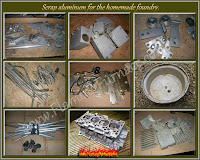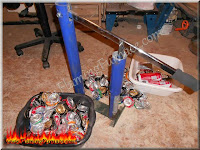It's been a while since I posted a new project, time is very scarces these days and things I like to do are pushed aside by day to day tasks. This post is about how I turned used scrap aluminum cans into something new. My work colleagues collected aluminum drink cans for me for the last few months. I decided to make them something useful and I came up with ......Individual paper weights for each of them with their name initials on them.
Unfortunately I don't have a small CNC machine, something that I hope to buy or build one day. So my second option was to make the foundry patterns from A-Z.
As for the material for the patterns I decided to use 18mm MDF, and yes I know it's not a really "fun" material to work with but its easy to shape and for this type of pattern it was perfect.
So first I decided what radius to make the aluminum name plates, then I made a rough cut with a jig saw around the marked radios. From a previews job I already had a perfect circle cut so I used it as a template for all the name plates.
The next part was all done with my electric router, first I shaped the pattern into a perfect circle using a template and a router "Flush Trim bit", then I made another MDF Jig in order to create the pattern middle radius recess, for this job I used "Straight bit" + router collar.
After I created all the pattern inner circles (the same depth as the letters 3mm) I used a "Chamfer bit" to create a decorative 45° angle on the top side of the pattern.
After creating the pattern I covered the MDF with putty then sanded it to a smooth finish. After I got rid of the horrible MDF fiber texture it was smooth enough to stick to the foam letters. The last part was to give the patterns a few coats of paint and varnish. The paint and varnish really contribute to achieve a very good sand casting and aluminum casting results.
This first series of images illustrates the pattern making stages:
After the pattern was finished I moved to the next stage, creating the sand casting cavity for the molten aluminum to fill. I used oil bonded sand for this casing to achieve a higher finishing quality. Making the sand mold was a very easy process as its just a flat pattern made from one part. When I carefully removed the pattern from the sand the sand was left with a perfect impression of the patterns.
One mistake that I did was ramming the sand in the flask cope part to lightly as result there was a bit of a crack in the sand that I chose to ignore (mistake). The problem occurred when I was pouring the molten aluminum into the sand mould cavity. The molten metal lifted the sand up like a cake in the oven. What I should have done is create the cope part again or place some weight on top of the sand, that would of prevented it from rising. The casting defect that I have created is called "flash" and it could have been very easily avoided.
Next set of images are from the first casting session:
I could of just left it the way it was but it was annoying me that the base side of the name plates was uneven, one side of the plates base was higher then the other side. Unfortunately I also don't have a Lathe machine and using a hand grinder was out of the question. I decided to make another sand casting this time paying more attention to details from A-Z including a better gating system using some scarp hard wood as a gating pattern.
The second casting was perfect with very good casting results.
Next sets of images are from the second casting session.
As this was a very good casting It didn't take me long too clean all the excess aluminum. Using metal file and electric sander I got it to a stage ready for polishing. For the polishing part one needs a lot of patience as it takes time to make it shiny. I used aluminum brown and blue buffing compound.
The end result was good enough for me and I gave it as a present to my work colleagues. Now they have a fancy paper weight for their desks :-)
This is a short video that I made of the aluminum name plates, creation stages:

























































.JPG)
